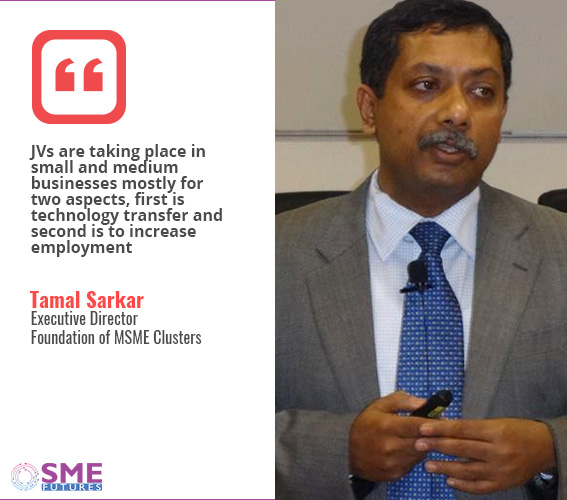The globalised world has changed how one does business. The opened up market meant more competition. But it also meant more opportunities, especially if the company is open for partnerships. Traditionally collaborations meant access to resources of other organisations as well as local management expertise. This is especially a win-win situation for SMEs with limited resources.
In today’s scenario, not only large firms are into strategic partnerships with foreign companies, but also mid size businesses have a fair share of joint ventures across the globe. In fact, Tamal Sarkar, Executive Director, Foundation of MSME Clusters, believes that small and medium businesses in India should be more open to joint ventures and collaborations. “JVs are taking place in small and medium businesses mostly for two aspects, first is technology transfer and second is to increase employment,” says Sarkar.

This is especially true in the case of companies that manufacture machine tools. According to Gardner Business Index (GDI) released in 2017, India is ranked 12th in the production of machine tools in the world and eighth in the consumption of them. The GDI pegs production at Rs 5,803 crore in 2016-17. When compared with previous year-on-year, it is 23 per cent more.
Experts pinpoint government reforms as the reason why manufacturing sector is seeing growth. Predictably, these reforms have attracted many foreign investors. That the government is putting infrastructure in place has sweetened the deal for the foreign investors. According to a report by UBS, a global financial service provider, annual FDI inflows in the country are expected to rise further to $75 billion over the next five years. Also the World Bank has stated that private investments in India is expected to grow by 8.8 per cent in FY 2018-19 to overtake private consumption growth of 7.4 per cent, and, thereby, drive gross domestic product (GDP) growth in FY 2018-19.
Infact, according to Department of Industrial Policy and Promotion (DIPP), the total FDI investments in India April-June 2018 stood at US$ 12.75 billion, indicating that government’s effort to improve ease of doing business and relaxation in FDI norms is yielding results.
Data for April-June 2018 indicates that the services sector attracted the highest FDI equity inflow of US$ 2.43 billion, followed by trading – US$ 1.63 billion, telecommunications – US$ 1.59 billion and computer software and hardware – US$ 1.41 billion. Most recently, the total FDI equity inflows for the month of June 2018 touched US$ 2.89 billion.
During April-June 2018, India received the maximum FDI equity inflows from Singapore (US$ 6.52 billion), followed by Mauritius (US$ 1.49 billion), Japan (US$ 0.87 billion), Netherlands (US$ 0.84 billion), and United Kingdom (US$ 0.65 billion).
Quite recently, Taiwan-based company, Amax Systems, which deals in various industrial machinery manufacturing as well as software design and fabrication, entered the Indian market. The company has an office in Naraina industrial area of the National Capital Region. Mubarak Khan its Indian representative says, “Over the last few years, foreign investments have grown huge. Companies are coming here as suppliers or investors as government has mended rules. As a foreign company representative, in my own experience Indian companies go for joint ventures to tap technologies that are not readily available here or for cheap products. Also companies look for expanding footprints in foreign lands for better growth opportunities and joint ventures bring more jobs to our land.”
For instance, thanks to Make in India drive, India is all set to become the hub for hi-tech manufacturing, as global giants such as GE, Siemens, HTC, Toshiba, and Boeing have either set up or are in process of setting up manufacturing plants in India, attracted by India’s market of more than a billion consumers and increasing purchasing power.
I feel lot of Chinese companies looking for setting up manufacturing units in India as they see a potential in India to take up at least the low end/tech manufacturing as china is getting expensive. And since it’s not easy to work in India they would definable need to team up with local Indian companies.” Says Jyoti Khanna, Director and promoter of Nipa International, an OEM & Manufacturer for Modular Switches.

Not just big players, but also SMEs now know the importance of global partnerships. They know gaining access to global markets can help their growth. Collaborations are now included as an essential market strategy move in their business road maps. Take the case of Alfa Machinery Maker, an original equipment manufacturer based out of Batala in Punjab. The company is into manufacturing capital goods better known as mother machinery. Says Rajesh Marwaha, one of the directors of the company: “Global markets offer us ample opportunities for becoming big. We manufacture essential parts in India, but we outsource our services to US. We have plans to explore the outsourcing option more in future.”
According to a research paper written by Sanghamitra Samal and D Venkatrama Raju of Bharath University in Chennai, between 2011 and 2015, FDI has had a positive impact on economic growth of the country. The cumulative amount of inflow of FDI was $350,963 million for the period from April 2000 to November 2014. While the FDI inflow to India during the financial year 2012-13 was $36,860 million, for 2013-14 was $36,396 million, for 2014-15 it was $27,401 million.
Going by the data, India is both investing in and is the preferred destination for investment of European Union and Asian countries like Korea and Taiwan. A very recent study proposed by SEMRush, a digital marketing suite revealed that India ranks first in online search for preferred destination to do business or setting up new ventures.
Rohan Ayyar, Regional Marketing Manager India, SEMrush, says the number of SMEs in India is 4.25 crore, registered and unregistered, with over 10 per cent average growth rate. He was quoting a report by EVOMA. “The GDP contribution by SMEs is estimated to be around 6.11 per cent from the manufacturing and 24.63 per cent from the service sectors,” he said. SEMrush analysed the global search pattern for the last 12 months and looked for certain key search terms such as ‘how to start a company in’, ‘opening business in’, ‘found a business in’ and other related search queries.

Also, it’s basically the technology that Indian businesses are spending their money on as foreign companies have comparatively better technologies. Says Sarkar of Foundation of MSME Clusters, “It’s the technology that we are still behind in. There is no lack of funds, Indian investment capacity is not limited. Foreign investments are not prerequisite unless investment is done where technology is must. We are only lacking in green and clean energy and these are the area where technology is very much required.”
CEO of Chennai-based Hitek Engineers, Krishnan Shriram, is of the view that India lags behind in technology because of policy restrictions. “One of the major setbacks is that we do not believe in home made technologies. We have inventions but there are not policies to take them to the next level. That’s why we have to depend on foreign technologies.”
It is also small things like attitude that make a huge difference to a SME opting for collaboration with foreign companies. “Foreign companies have a positive attitude, they are transparent and punctual. Their work ethics are different. These affect us in a positive way,” says Khan of Amax Systems. Moreover it is also impacting consumerism, Marwaha of Alfa Machinery Maker says, “Joint ventures are beneficial for consumers as we are getting quality goods as a consumer.” For instance, he points towards the cars and electric appliances that we get today in our markets. They are of world-class quality and have pushed our standards of living higher.
Though joint ventures are fruitful, another aspect of joint ventures that businesses don’t ignore is possibilities of overhauling the innovative capacity when working in collaboration with foreign company. It is sometimes challenge for small business to control the stakes while sharing risk and costs among the collaborations. Aman Gulati, CTO of Galaxy offset, A Delhi based print firm also believes that it could be a disastrous challenge for a small business, “In my opinion, governing power can often be a challenge when any business is with partnership with foreign partners. Also demand in Indian Market varies from milestone to milestone, which cannot be ignored by working model of foreign partners.” While Khanna says, there are ample of possibilities of overhauling if one is not attentive, “Yes incase of Joint venture, it is needed to add capacity and modernise the business. Otherwise it doesn’t make sense to get into collaboration, if a business doesn’t gain anything from the partners expertise.

Today, joint ventures and collaborations have not only emerged as an industrial trend but it is also a core competency for leading business across industries. Especially, manufacturing segment in India will always show upward growth, since India is a huge market and none of the international players wants to ignore Indian Market.











